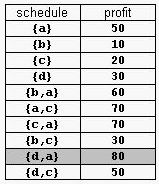POJ1456 supermarket [并查集]
Supermarket
| Time Limit: 2000MS | Memory Limit: 65536K | |
| Total Submissions: 15192 | Accepted: 6855 |
Description
A supermarket has a set Prod of products on sale. It earns a profit px for each product x∈Prod sold by a deadline dx that is measured as an integral number of time units starting from the moment the sale begins. Each product takes precisely one unit of time for being sold. A selling schedule is an ordered subset of products Sell ≤ Prod such that the selling of each product x∈Sell, according to the ordering of Sell, completes before the deadline dx or just when dx expires. The profit of the selling schedule is Profit(Sell)=Σx∈Sellpx. An optimal selling schedule is a schedule with a maximum profit.
For example, consider the products Prod={a,b,c,d} with (pa,da)=(50,2), (pb,db)=(10,1), (pc,dc)=(20,2), and (pd,dd)=(30,1). The possible selling schedules are listed in table 1. For instance, the schedule Sell={d,a} shows that the selling of product d starts at time 0 and ends at time 1, while the selling of product a starts at time 1 and ends at time 2. Each of these products is sold by its deadline. Sell is the optimal schedule and its profit is 80.

Write a program that reads sets of products from an input text file and computes the profit of an optimal selling schedule for each set of products.
For example, consider the products Prod={a,b,c,d} with (pa,da)=(50,2), (pb,db)=(10,1), (pc,dc)=(20,2), and (pd,dd)=(30,1). The possible selling schedules are listed in table 1. For instance, the schedule Sell={d,a} shows that the selling of product d starts at time 0 and ends at time 1, while the selling of product a starts at time 1 and ends at time 2. Each of these products is sold by its deadline. Sell is the optimal schedule and its profit is 80.

Write a program that reads sets of products from an input text file and computes the profit of an optimal selling schedule for each set of products.
Input
A set of products starts with an integer 0 <= n <= 10000, which is the number of products in the set, and continues with n pairs pi di of integers, 1 <= pi <= 10000 and 1 <= di <= 10000, that designate the profit and the selling deadline of the i-th product. White spaces can occur freely in input. Input data terminate with an end of file and are guaranteed correct.
Output
For each set of products, the program prints on the standard output the profit of an optimal selling schedule for the set. Each result is printed from the beginning of a separate line.
Sample Input
- 4 50 2 10 1 20 2 30 1
- 7 20 1 2 1 10 3 100 2 8 2
- 5 20 50 10
Sample Output
- 80
- 185
Hint
The sample input contains two product sets. The first set encodes the products from table 1. The second set is for 7 products. The profit of an optimal schedule for these products is 185.
传送门(用堆的解法)
分析:首先思考,肯定是先卖价值更高的商品赚得利润更多,那么就可以按照价值先排个续,每次尽可能的将商品晚一点卖;那么问题就在于如何记录已售货的天数,直接开数组什么的肯定是别想了。这里用的方法是并查集,建立一个天数的并查集,每次只要在某一天售出了物品,那么就将它并入前一天的并查集,以方便每一件物品都是尽可能晚售出,且不会有前面的空闲天数剩下。正确性易证。
Code:
- #include<cstdio>
- #include<cstring>
- #include<cstdlib>
- #include<cmath>
- #include<iostream>
- #include<iomanip>
- #include<algorithm>
- #define Fi(i,a,b) for(int i=a;i<=b;i++)
- using namespace std;
- const int N=1e4+7;
- int n,fa[N],ans;
- struct Node{int v,d;}a[N];
- bool cmp(Node x,Node y)
- {return x.v>y.v;}
- inline int find(int x)
- {return fa[x]==x?x:fa[x]=find(fa[x]);}
- inline void work()
- {
- Fi(i,1,n)cin>>a[i].v>>a[i].d;
- Fi(i,1,N-1)fa[i]=i;ans=0;
- sort(a+1,a+n+1,cmp);
- Fi(i,1,n){int f=find(a[i].d);if(!f)continue;
- ans+=a[i].v;fa[f]=f-1;}
- cout<<ans<<"\n";
- }
- int main()
- {
- ios::sync_with_stdio(false);
- while(cin>>n)work();
- return 0;
- }
蒟蒻写博客不易,如果有误还请大佬们提出
如需转载,请署名作者并附上原文链接,蒟蒻非常感激
名称:HolseLee
博客地址:www.cnblogs.com/cytus
个人邮箱:1073133650@qq.com
如需转载,请署名作者并附上原文链接,蒟蒻非常感激
名称:HolseLee
博客地址:www.cnblogs.com/cytus
个人邮箱:1073133650@qq.com




【推荐】国内首个AI IDE,深度理解中文开发场景,立即下载体验Trae
【推荐】编程新体验,更懂你的AI,立即体验豆包MarsCode编程助手
【推荐】抖音旗下AI助手豆包,你的智能百科全书,全免费不限次数
【推荐】轻量又高性能的 SSH 工具 IShell:AI 加持,快人一步